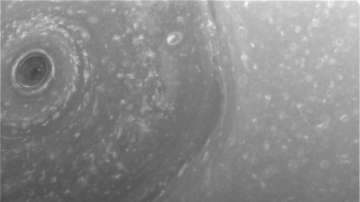US space agency NASA’s Cassini spacecraft orbiting Saturn has sent its first views of the planet’s atmosphere showing scenes from high above the planet's northern hemisphere, including an intriguing hexagon-shaped jet stream.
Cassini began its new mission phase, called Ring-Grazing Orbits, on November 30.
Each of these week-long orbits - 20 in all - carries the spacecraft high above Saturn’s northern hemisphere before sending it skimming past the outer edges of the planet’s main rings, NASA said.
NASA's Cassini spacecraft captures first images of Saturn’s atmosphere
Cassini’s imaging cameras acquired these latest views on December 2 and 3, about two days before the first ring-grazing approach to the planet, it said.
Future passes will include images from near closest approach, including some of the closest-ever views of the outer rings and small moons that orbit there.
“This is it, the beginning of the end of our historic exploration of Saturn. Let these images - and those to come - remind you that we have lived a bold and daring adventure around the solar system’s most magnificent planet,” said Carolyn Porco, Cassini imaging team lead at Space Science Institute in the US.
The next pass by the rings’ outer edges is planned for December 11. The ring-grazing orbits will continue until April 22, when the last close flyby of Saturn’s moon Titan will once again reshape Cassini’s flight path, NASA said.
With that encounter, Cassini will begin its Grand Finale, leaping over the rings and making the first of 22 plunges through the 2,400-kilometre gap between Saturn and its innermost ring on April 26.
On September 15, the mission’s planned conclusion will be a final dive into Saturn’s atmosphere. During its plunge, Cassini will transmit data about the atmosphere’s composition until its signal is lost.
Launched in 1997, Cassini has been touring the Saturn system since arriving in 2004 for an up-close study of the planet, its rings and moons.
Cassini has made numerous dramatic discoveries, including a global ocean with indications of hydrothermal activity within the moon Enceladus, and liquid methane seas on another moon, Titan.
(With inputs from PTI)
Latest World News
